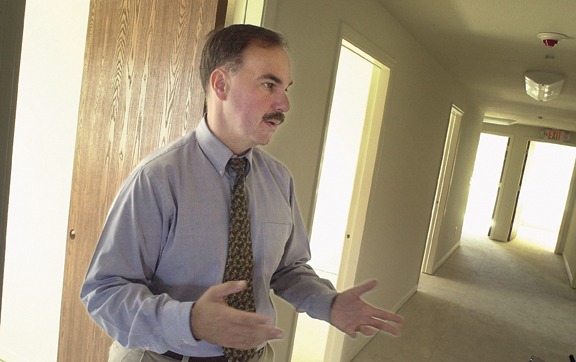
The first women’s shelter in San Benito County is nearing
completion after eight years in the making.
With the completion of Emmaus House, battered women and children
in the county will finally have a place to receive hope and
encouragement while trying to start a new life.
Rev. David Rodriguez of the First Presbyterian Church formulated
the idea for the shelter in 1995, in a discussion he and a friend
were having on the homeless problem in the county.
The first women’s shelter in San Benito County is nearing completion after eight years in the making.
With the completion of Emmaus House, battered women and children in the county will finally have a place to receive hope and encouragement while trying to start a new life.
Rev. David Rodriguez of the First Presbyterian Church formulated the idea for the shelter in 1995, in a discussion he and a friend were having on the homeless problem in the county. They decided to focus on the most vulnerable sector of the homeless, which they felt were battered women and children.
Every year there are about 365 cases of domestic abuse in the county and without a local shelter the women are forced out of the area to find a safe place to live. Many women who can’t afford to leave the area become stuck in a violent cycle with no way out, Rodriguez said.
The location of the nine-bedroom facility was originally to be kept secret from the public for the occupants’s safety. However, Rodriguez found that to comply with the multitude of permits and planning they would have to go through to build the shelter, no matter how evasive they tried to be there was no way of getting around it becoming public.
After resigning themselves to the fact that the shelter’s location would be public they began looking at sites that would provide the highest level of security.
The first location they found was the second story of the old county jail in downtown Hollister above the current San Benito County Sheriff’s Department. They reasoned that if they remodeled the jail it would severely hinder abusers from trying to break in, because they would have to go through the sheriff’s deputies first, he said.
That idea was shot down by the sheriff at the time, Harvey Nyland, who said at a Board of Supervisors meeting he didn’t want the dust and commotion above his office, Rodriguez said.
“He said, ‘Not in my backyard,’ into a microphone at the meeting,” Rodriguez said.
The Board then told Rodriguez none of their facilities could be used because they were worried about insurance liability. When this information was printed in the newspaper, the mayor of Hollister at the time, Richard Boomer, called Rodriguez and offered to let them have a city-owned house on the corner of Valley View and Sunnyslope Road.
“The city gave us this piece of property for $1 a year,” Rodriguez said.
The house on the property was demolished in 1998 (because it was cheaper to tear it down and build a new one than remodel the existing one), and construction began on the current house.
Jade Sandifer, of Blue Print Design, volunteered to draw up the plans for the house and worked with Rodriguez to design the safest facility they could.
They modeled it after a publicly known shelter in Salinas called Shelter Plus, which has never had a problem with abusers trying to break in or harass the residents, and specifically designed Emmaus House to be even more secure, he said.
Safety features include burglur alarms, motion detectors, fire alarms, sprinklers, strobe lights that will go off in case of a fire for hearing impaired residents, and a heavy steel door that people must be buzzed through to enter the facility.
“And the police told us they can get here in a heartbeat,” he said.
If having to call the police because abusive husbands or boyfriends know where they’ll be will hinder women from coming to the shelter all depends on how they feel individually about getting out of their current situation, Rodriguez said.
“They’ve been so traumatized,” he said. “Their (other) options are to go back to their abusers or go to a shelter that’s outside the county.”
Once the shelter has been up and running for a year it will qualify for grants from outside organizations, like the State of California, which will provide funding for the day-to-day operations.
Until then local businesses, private contributors and a legion of volunteers will continue to do what they’ve been doing for the past eight years – donating time and money into seeing their goal come to fruition.
The facility will need around $100,000 a year to operate, but this somewhat daunting figure doesn’t have Rodriguez worried.
“It won’t be a problem,” he said. “People didn’t think we’d be able to do this.”
Bringing the shelter into the limelight has been a blessing in disguise, motivating the community to get behind the shelter and make residents aware of the need for a safe haven for these families, Rodriguez said.
“Once this community’s aware of a need, this community responds to a need,” he said.
Emmaus House has enticed various types of people to volunteer their time or donate to the facility. People who grew up watching their father abuse their mother, or women who had been in an abusive relationship hope to facilitate a proactive movement within the community to help stop domestic violence, Rodriguez said.
“It’s helpful for these folks to do something,” he said. “It’s helpful for their own personal healing process.”
To be able to open by Christmas is Rodriguez’ goal. Holiday tidings bring with them an increase in domestic abuse because of added financial stress and aggravated substance abuse.









